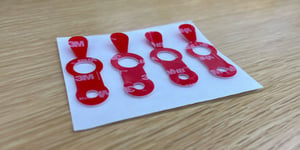How often do you pay attention to the part of the sticker you peel off?
Adhesive liners fulfill a necessary purpose, and despite the relative simplicity of their appearance, liner issues will have unfortunate effects on your project.
As a flexible material converter, Strouse specializes in working with rolls of adhesive material. We’ve seen many adhesive liner problems over the years, so we wanted to compile the potential issues you might encounter.
These examples will reference what could occur during your product development process and offer solutions for improving your design.
Adhesive Liners: What Goes Wrong
Wouldn’t it be great if you could guess the right liner on the first try?
Unfortunately, predicting liner compatibility with flawless accuracy can be challenging, so it often becomes more of a trial-and-error process.
Let’s look at adhesive liner issues so we can address them with possible solutions.
1. USING THE WRONG TYPE OF LINER
There are two primary types of adhesive liners: paper and film.
If you’re experiencing issues with your adhesive wrinkling or cutting improperly, you might be using the wrong type of liner for the intended material.
DIE CUTTING ISSUES
Paper liners sometimes risk tearing when it comes to die cutting, since you’re essentially crushing them with the blade, whereas film liners are more durable.
Paper liners are often thinner and provide less resistance than film liners. However, film liners may require more substantial tooling due to their increased rigidity.
In addition, the type of liner you use could determine the state of your adhesive. Paper liners get more dust and debris in the air when they’re cut, which can settle on the product or its adhesive.
Most medical, electronic, and optically clear applications possess film liners to avoid the slightly dusty side effects of cutting a paper liner.
DESIGN VARIABILITY
When you leave a coating on a liner, it becomes difficult to print, making it challenging to leave marks for sensors (registration marks). Film liners offer more variations in coatings and thicknesses than paper liners, but they are harder to print on.
The inability to print registration marks could become a more prominent downside in your production or automation process.
2. RELEASE IS THE WRONG STRENGTH
Is your part sticking to the liner a little too well? Or, maybe it’s not clinging enough.
Adhesive liner release strengths are adjustable depending on the ease of removal you’re looking for. Adhesive liners are classified as easy, medium, or tight release (with many levels in between).
The tightness of your liner is a crucial factor in automation. When you’re automating your product, you’ll need to determine the point at which it can be peeled easily without falling off the liner of its own accord.
Ease-of-release is also an essential consideration for hand application. The parts must fulfill their purpose, but not at the cost of sticking to the liner hard enough to disrupt the production process.
For instance, you might begin with an easy-release paper liner, but if too many parts keep falling off, you could switch to a tight-release liner.
You can also adjust the design to have additional features like tabs or folded liners to improve the application while maintaining a tight release.
3. THE THICKNESS IS OFF
The thickness of your liner can cause problems with the structural integrity of the part and its application.
If the liner is too thin, the part might crumple too easily. A thicker liner will allow the material to hold its shape better, but it depends on the application you’re looking for. Thick liners are heavier and harder to pull through a machine, so they may not always suit your application.
If there is a deviation in the thickness, whether lot-to-lot or across the web, it can completely stop a converting process.
Do you plan on receiving your part in a roll or a sheet format? Questions like this will allow you to plan ahead by selecting the most applicable liner from the get-go.
How Can You Fix Adhesive Liner Issues?
Before you decide upon a solution, consider the type of adhesive release you want:
- Do you want the liner to peel easily?
In that case, you’ll want to try using a lower or easier-release coat.
- Are you looking to reduce the flimsiness of your part?
Try using a thicker liner to add more resistance.
- Got multiple adhesive liners peeling simultaneously?
This is referred to as “liner confusion,” and can be solved by changing the strength of the adhesive release on one side of the part to create more peel leverage.
One way to test adhesive liners is through peel testing, which allows you to determine the exact strength required to peel the liner from the adhesive. Peel testing is especially beneficial for automated processes with consistent peel strength.
Choosing the Right Liner
Above all else, the release vale of a liner needs to be tailored to the application. Determining the right liner for your part is often a trial-and-error process that involves testing samples.
Are you in your product testing phase and ready to determine the liner that best fits your adhesive? Try Strouse’s sample-making process:
Once you’ve tested the adhesive release for your part, you’ll know whether a certain level of peel adhesion suits your project.
If you’re not seeking samples but want to learn more about adhesive bonding, check out our Learning Center.







